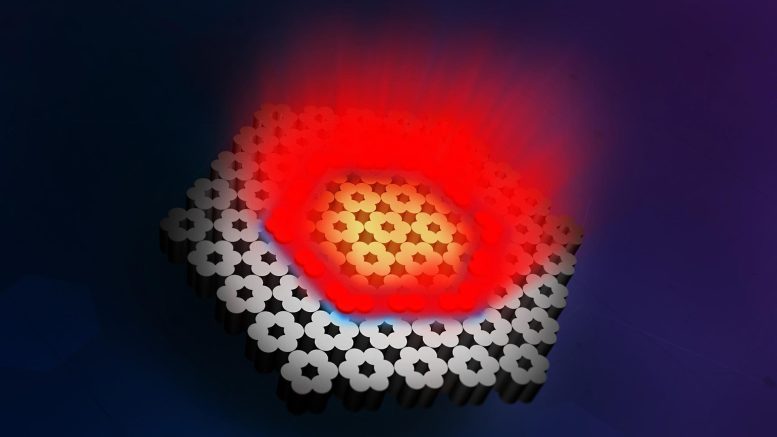
Photonic Chip Combines Many VCSELs into Single Laser
Researchers from the Technion-Israel Institute of Technology and the University of Würzburg successfully forced an array of vertical-cavity lasers to act together as a single laser — a highly effective laser network the size of a grain of sand.
Vertical-cavity surface-emitting lasers (VCSELs), widely used in applications such as cell phones, car sensors, and data transmission, measure just a few microns, which sets a strict limit on the output power they can generate. Scientists have taken many approaches in efforts to enhance the power emitted by such devices by combining many VCSELs and forcing them to act as a single coherent laser, though with limited success.
In the current work, the collaborators used a geometrical arrangement of VCSELs on the chip and formed a photonic topological insulator platform.
Topological insulators are quantum materials that insulate on the inside but conduct electricity on their surface without loss. The technology, developed by Mordechai Segev, a professor at Technion and one of the senior researchers on the current project, was demonstrated in 2018 by Segev’s team to force many micro-ring lasers to lock together and act as a single laser.
That system still had a major bottleneck — light was circulating in the photonic chip confined to the same path used to extract light. The whole system was again subject to a power limit imposed by the device used to get the light out, similar to having a single socket for a whole power plant.

Israeli and German researchers developed a way to force an array of vertical cavity lasers to act together as a single laser — a highly effective network the size of a grain of sand. This artistic rendition shows a topological array of vertically emitting lasers in which 30 microlasers along a topological interface (blue) act as one, collectively emitting coherent laser light (red). Courtesy of Pixelwg, Christian Kroneck.
The lasers in the current work are forced to lock within the planar chip, but the light is emitted through the surface of the chip from each tiny laser and can be easily collected.
“We went from fundamental physics concepts to foundational changes therein, and now to real technology that is now being pursued by companies,” Segey said. “Back in 2015, when we started to work on topological insulator lasers, nobody believed it’s possible, because the topological concepts known at that time were limited to systems that do not — in fact cannot — have gain. But all lasers require gain. So topological insulator lasers stood against everything known at that time.”
The team relied on the concepts of topological photonics with VCSELs that emit the light vertically, while the topological process responsible for the mutual coherence and locking of the VCSELs occurs in the plane of the chip. The result was a powerful and very compact and efficient laser, not limited by a number of VCSEL emitters and undisturbed by defects or altering temperatures.
“The topological principle of this laser can generally work for all wavelengths and thus a range of materials,” said German project leader Sebastian Klembt, a professor at the University of Würzburg. “Exactly how many microlasers need to be arranged and connected would always depend entirely on the application. We can expand the size of the laser network to a very large size, and in principle it will remain coherent also for large numbers.”
The results of the study are expected to support applications involving medical devices, communications, and more.
The research was published in Science (www.doi.org/10.1126/science.abj2232).
Published: September 2021